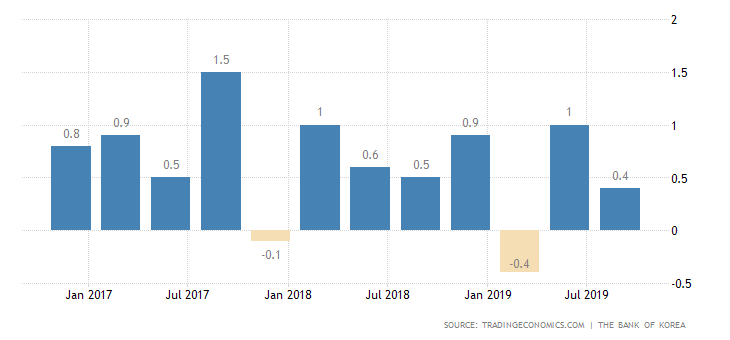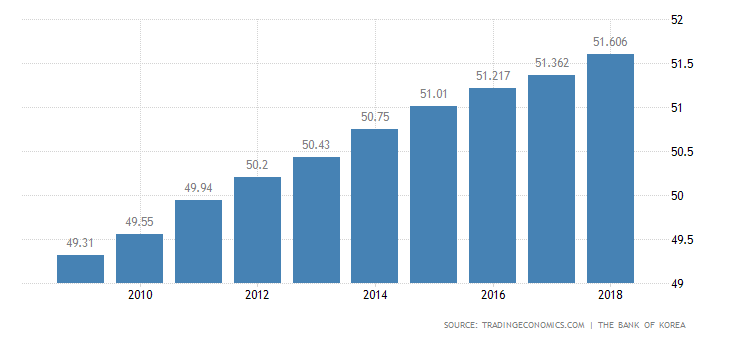South Korea Potential for IKEA
South Korea is currently among the countries with a stable economic and political situation that attracts foreign business. IKEA is a Swedish enterprise that entered the Korean market in 2014 and currently operates two facilities, and the third one is under construction (Bae, 2018, para. 1). The brand mainly focuses on selling furniture and related home products, as well as some types of food. Before coming to South Korea, IKEA successfully operated in other countries, especially in Europe and the U. S.
Nowadays, the Asian region seems to have many opportunities for foreign direct investment (FDI). Specifically, South Korea is experiencing stable economic growth, and the country’s population is growing wealthier (South Korea: economic and political outline, 2019, para. 3). In this situation, a shift in demand occurs, as people experience a rise in income (Gillespie, 2016, p. 56). Koreans become interested in furniture and home décor that meets the world trends in interior design. IKEA may successfully compete on the market with smaller local businesses to respond to this need.
Background Information on IKEA
Operating for several decades, IKEA has grown into one of the most well-known furniture retailers in the world. Nowadays, it operates 430 stores in 52 countries based on a complex franchise system (IKEA franchisees, 2019). It includes eleven groups of companies, each responsible for a set of locations. Ingka Group, being the largest one of them, governs operations in 372 stores, including those in South Korea.
The financial performance demonstrates that IKEA has been successful over the past year. The sales rates increased by 6.5% compared to 2018, and the total amount reached 41.3 billion euros (Inter IKEA Group FY19 financial performance, 2019, para. 2). The data includes the sales of retail products, food, and customer services. As IKEA became dedicated to developing online retail, the growth in e-commerce revenues reached 43% compared to the previous period (Inter IKEA Group FY 19 financial performance, 2019, para. 7). The company spends much of its income on various development initiatives. For instance, 175 million euros were invested in designing innovations associated with products, materials, and retail models (Inter IKEA Group FY 19 financial performance, 2019, para. 4). Some of the new items launched recently include smart blinds, remote controls and speakers, as well as the Home smart app. There is a tendency of creating products that would help to technologically upgrade a living space.
The company’s international network is very diverse, yet every location is set up according to the single IKEA vision. The two facilities operating in South Korea are located in Gwangmyeong and Goyang (Bae, 2018, para. 3). The new outlet is planned to be opened in Giheung-gu, Yongin by the end of this year. The company is on the top hiring list, with 700 new staff members employed only in 2018 (Bae, 2018, para. 5). Its revenue in the area in 2017 reached $326.1 million, with 6.5 million customers visiting the stores (Bae, 2018, para. 7). The numbers demonstrate the high potential of IKEA network development in South Korea.
Background Information on the Business Environment in South Korea
Although the business environment in South Korea has mainly positive tendencies, the situation across different sectors is not uniform. The changing demographic profile forces changes in the sphere of technological development. Despite the stable economic growth, the country may be affected by the ongoing trade war between the U.S. and the Asian region, specifically China. Moreover, there is a trend of the government trying to improve relations with North Korea, which may influence the country’s politics. All these forces create the base for a PESTLE analysis (Wetherly, 2018, p. 25), which should be considered by IKEA when developing strategies for this market. Below is an overview of the political, economic, social, technological, legal, and environmental situation in South Korea.
Political Factors
South Korea is considered a politically stable country with a robust governmental position. It is a republic governed by liberal and conservative parties, with the president Moon Jae-in as the head of state (South Korea, n. d., para 1). The aggregate freedom score for South Korea is 83 out of 100, which is considered very high. The ratings for freedom, political rights and civil liberties are determined as 2 out of 7, where the least number is the best result (South Korea, no date, para. 1). While there are specific issues like minority rights, Korean society experiences respect for personal freedom.
The recent developments in the country’s politics allow concluding that the government is interested in maintaining good relationships with the rest of the world. One of the most important factors is the attempts of the current president to set up a dialogue with the leader of North Korea (South Korea, no date, para. 2), as the rapprochement of the two states may increase the level of stability in the region and attract foreign business. However, there may be a high level of corruption among government officials. For example, the former president was impeached due to the corruption scandal in 2017 before being sent to prison (South Korea, no date). This may be a sign that some administration executives can make it difficult to enter the market.
Economic Factors
South Korea has demonstrated remarkable growth over the past several decades. It is currently one of the largest economic powers in the world, being at the fourth place in the Asian region (South Korea: economic and political outline, 2019, para. 1). Although the country’s wellbeing is affected by weakening exports and the lack of investment, the GDP level remains stable over the past few years.

The dependence on export and international trade are one of the weakest sides of the South Korean economy. Moreover, the competition from China is growing, as this country is becoming more successful in the global market (South Korea: economic and political outline, 2019, para. 2). Currently, as giant foreign corporations begin operating in South Korea more frequently, the government tries to protect local businesses. For example, the country protects presently small shops by restricting large retailers like E-mart by keeping the latter closed two Sundays a month (Yoon, 2018, para. 4). The same measures may eventually be applied to IKEA in the future.
Social Factors
The country’s demographics shape the current economic situation in South Korea. There are currently about 51 million citizens (South Korea social economy report, 2019), and many people are growing wealthier – the country is successfully combatting poverty. The majority of the population lives in big cities, especially in Seoul, and the density is one of the largest in the world due to the limited territory.

At first glance, the situation seems beneficial for companies like IKEA, as there is an expanding market with growing opportunities. However, two main issues are facing Korean society, being the population ageing and the potential unemployment growth. There is currently a rapid decline in the number of working-age people, which sets the country as a leader for this factor among OECD member states (Kim, 2019, para. 2). Companies are currently struggling to design technologies that would effectively substitute people in the workplace. Although it may help to solve the issue of employee shortage nowadays, robots in the future may take away the entire job sectors away from people.
Another issue in Korean society is the remaining gender inequality. It is determined that the country’s gender gap rate is the highest among the OECD members, being 37% (South Korea social economy report, 2019). The government is currently working on this issue by including it in the Sustainable Development Goals program. For example, salary disclosures should be done by businesses to allow identifying whether there are differences between what men and women receive for their work.
Technological Factors
Despite the need for developed technology mentioned in the previous section, South Korea relies heavily on machines and software import. It is estimated that the country is behind the U.S. and Japan by 20% to 30% (Kim, 2019, para. 4). However, South Korea is currently the leader in utilizing robots in manufacturing. Besides, the country stimulates small local companies to develop automated technology solutions. South Korea has also established the 5G network, which allows transmitting information more progressively. The country is home to Samsung corporation, which is one of the leading powers on the smartphone market. Most of the population uses smartphones, which is the possibility of establishing successful e-commerce.
Legal Factors
Although South Korea welcomes foreign companies, there are some significant restrictions. For example, such economic sectors as nuclear fuel processing, electricity generation, radio and TV broadcasting, media publishing, transportation and others are fully or partially restricted on foreign investment (Cho, Ahn, and Kim, 2019). Companies wishing to operate in Korea should also consider the local employment legislation, which is regulated by the Labor Standards Act (Cho, Ahn, and Kim, 2019). Other laws are associated with such matters as equal employment opportunities, insurance, and minimum wage.
The Korean government aims to ensure fair competition on the market. The Monopoly Regulation and Fair Trade Act may put some restrictions on businesses that are believed to engage in power abuse (Cho, Ahn, and Kim, 2019). For example, after the first IKEA store had opened in South Korea, it appeared that the prices on products were much higher than those in other countries (Kang, 2014, para. 1). The case was subject to review by the antimonopoly commission.
Environmental Factors
Becoming a technological giant over the past few decades resulted in a worsening environmental safety rating in South Korea. For example, the air quality in 2017 was the worst among all OECD members (South Korea economy report, 2019). Nowadays, climate action is one of the government’s priorities, as it is a part of the Sustainable Development Goals programme. For example, the taxes on liquid natural gas are lowered to reduce the use of thermal coal by the industries. The shifting perspective may help companies focused on sustainability to be competitive on the market.
Conclusion
IKEA is the multinational furniture and home décor retailer that has a successful business model. The market environment in South Korea seems to have significant potential for this brand. Its current initiatives in politics, economics, and environmental policy match the company’s operation style and sustainability approach. However, IKEA also needs to be regulated by Korean authorities to ensure fair pricing strategies and competition with small local businesses.
Reference List
Bae, I.Y. (2018) ‘IKEA to open third outlet in Korea’, Retail in Asia.
Cho, C.H., Ahn, C.S. and Kim, S.J. (2019) Doing business in South Korea: overview.
Gillespie, A. (2016) Foundations of economics. 4th edn. Oxford, UK: Oxford University Press.
IKEA franchisees (2019). Web.
Inter IKEA Group FY19 financial performance (2019). Web.
Kang, T.J. (2014) ‘IKEA to face probe in South Korea’, The Diplomat.
Kim, S. (2019) ‘South Korea’s robots are both friends and job killers’, Bloomberg Businessweek, Web.
South Korea (no date). Web.
South Korea GDP growth rate (2019).
South Korea population (no date).
South Korea social economy report (2019). Web.
South Korea: economic and political outline (2019).
Wetherly, P. (2018) ‘Introduction: “business” and its “environment” in a “globalizing world”’, in Wetherly, P. and Otter, D. (eds.), The business environment. 4th edn. Oxford, UK: Oxford University Press, pp. 3-32.
Yoon, J.Y. (2018) ‘IKEA may face mandatory regular closures in South Korea’, South China Morning Post.